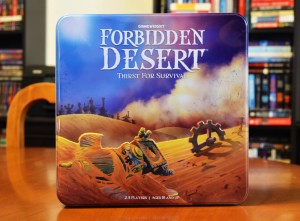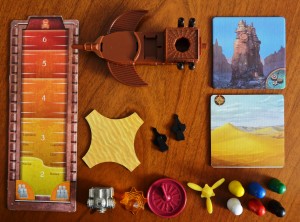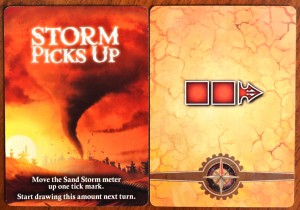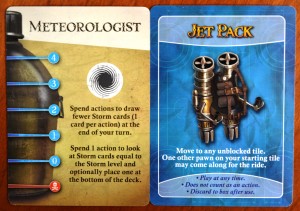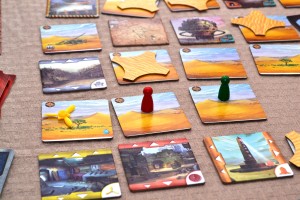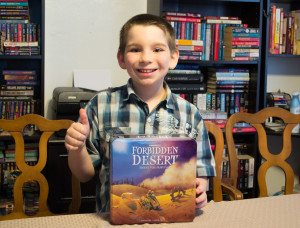I liked reviewing “Forbidden Island” for a lot of reasons…but the major sticking points revolved around how easy it was to play and its attractive cooperative theme. To steal a quote from said review, “Younger kids who enjoy the idea behind Pandemic but are overwhelmed by its rules and gameplay mechanics will probably enjoy Forbidden Island.” When I discovered “Forbidden Desert’s” existence, I knew that I had to give it a go to see how it compared to its predecessor. Before we take a look at this game in further detail, I’d like to thank Nora Meiners from Ceaco/Gamewright for providing me with a review copy.
Components
Cards – The game includes forty-nine cards, which is broken up into storm cards, equipment cards, and adventurer cards. The storm and equipment cards will form their own decks and will be utilized as the game goes on. Adventurer cards each list a special ability that players will be making use of to assist them in winning the game.
City/Desert Tiles & Pawns – As you may have guessed, these tiles are two-sided…one side has a picture of a city while the other has a picture of a desert landscape. Players will be navigating these tiles with their player pawns.
Sand Markers – These yellow plus-shaped tiles serve as a hinderance to players throughout the game. Depending on the circumstances, they may even prevent players from moving onto a particular tile.
Flying Machine Parts – There are four flying machine parts that players must find in order to win the game. They begin hidden among the tiles, but are revealed once players find clues as to their whereabouts.
Sand Storm Meter – This meter marks the intensity of the sand storm, the eye of which will be moving around the board throughout the game. The intensity on this meter is raised when “Storm Picks Up” cards are drawn from the storm deck.
Meter Clips – Meter clips are used to keep track a particular adventurer’s water level (each adventurer card has its own track). Players will be raising and lowering their water level as appropriate during gameplay.
Setup & Gameplay
First, players create the desert by mixing up the tiles (desert-side up) and placing them in a 5×5 grid. Since there are only twenty-four tiles, there will be a hole in the center of the grid (indicating the eye of the storm’s location). Sand markers are placed on the desert tiles in a predetermined fashion (see manual, link below). Each player receives one adventurer card and a pawn of the corresponding color. The storm level on the meter is set, depending on how many people are playing and how difficult they want the game to be. Finally, the storm and equipment cards are shuffled into their appropriate decks and placed off to the side, next to the flying machine parts. Player pawns start on the “crash site” and the thirstiest player goes first.
On a player’s turn, they may take up to four actions and may repeat a particular action should they so choose. The available actions include:
1) Move – The player may move to an adjacent tile (not diagonal). If a tile contains two or more sand markers, the player is forbidden from moving there. If a player is on a tile that contains two or more sand markers, they must first “unbury” themselves with the remove sand action.
2) Remove Sand – The player may remove a sand marker from the tile they occupy or from an adjacent tile.
3) Excavate – The player can flip the desert tile over to the city side IF there are no sand markers present. Some city tiles do different things (provide clues, raise water levels, etc.), so players will need to react accordingly.
4) Pick up a Part – The player can pick up a machine part assuming there are no sand markers present.
At the end of a player’s turn, they’ll draw sand storm cards equal to the number listed on the sand storm track. As noted above, the number on this track can increase as “Storm Picks Up” cards are revealed from the storm deck. These storm cards instruct players as to how the eye of the storm moves around the board, adding sand markers in its wake. Since there are twenty-four tiles in this 5×5 grid, the hole will represent the current location of the eye, with tiles shifting as necessary to accommodate its movement.
Some tiles have special symbols on them that will affect players in various ways. Three of the desert tiles contain a water symbol on them that, when excavated, provide EVERY player currently on that tile with two notches to their water level. One of these is a mirage however and thus provides no water. Some tiles have gear symbols on them, allowing the player to draw from the equipment deck. These cards can be traded with other players and generally serve to improve their odds over the course of the game.
Excavating tiles is also necessary in order to reveal clues as to the four machine parts’ whereabouts. For every machine part, there are two clue tiles. These clue tiles indicate the row and/or column in which the hidden part is buried. If players manage to reveal two clues unique to a certain part, they place the part at the intersection in which these two clues meet. If players manage to collect all four parts and return to the launch pad, they win the game!
While there is only one way to win, there are many ways to lose. If any one player’s thirst level reaches the skull and crossbones symbol, they die of thirst and everyone loses. If a player needs to add a sand marker to a tile but there are none left in reserve, everyone loses. If the sand storm meter reaches the skull and crossbones symbol, everyone loses. Needless to say, there’s a lot to keep an eye on!
The above doesn’t cover all of the rules found in the manual, but should give you an idea as to how the game is played. For more information, you can download a copy of the manual here:
http://boardgamegeek.com/filepage/90697/official-rules-forbidden-desert
The Review
I’ll say this…the game is incredibly eye-catching. I loved the art style that “Forbidden Island” adopted and I’m just as pleased with the art style here. Everything from the tiles to the cards were fun to look at…I especially liked the art on the “Storm Picks Up” cards. The components were solid and of fairly good quality, so no complaints there. Like its predecessor, the game came in a sturdy tin case. The box insert was also well made, holding all of the components properly and for the most part, securely.
I guess the most important question to ask is: “Is “Forbidden Desert” simply a “Forbidden Island” clone?” My answer to that is yes and no. “Forbidden Desert” carries over a lot of the ideas found in its predecessor, but adds new mechanics that serve to switch things up a bit. “Forbidden Island’s” water level track is comparable to the sand storm level track in that they both track nature’s intensity and serve as a timer for a game ending condition. “Storm Picks Up” cards are equivalent to “Forbidden Island’s” “Waters Rise!” cards as they both function the same way. Both games task players with finding four objects and returning to a particular tile in order to win the game. It goes without saying that those who have played “Forbidden Island” will be able to jump into “Forbidden Desert” without much trouble.
With that said, I’d be negligent in my duties if I didn’t recognize the new concepts that “Forbidden Desert” introduces. For one, players don’t need to collect treasure cards in order to win those four objects necessary to win the game. Instead, they simply need to excavate two of the clues of that object to reveal its location on the board. I found that this change in gameplay made things less complicated and less cluttered. I did find however that I missed the mechanic in “Forbidden Island” that involved tiles being removed from gameplay forever. The visualization of the board disappearing around you really gave me a sense of foreboding doom. The only visual que that made me worry about losing in this manner was the reserve pile of sand markers. Don’t get me wrong, “Forbidden Desert” is still pretty intense, but I really liked the sinking tiles mechanic featured in “Forbidden Island”.
I did take issue with the way the “Wind Blows” cards were designed…I could be wrong, but I kept wanting to do the opposite of what they indicated. A “Wind Blows” card has squares listed on the card along with an arrow. I kept wanting to move the eye of the storm (the empty space) in the direction of the arrow as it felt more natural. Rather, the arrow indicates the direction in which the tiles behind it need to travel, with the eye of the storm moving in the opposite direction. I’ve often been told that I have an odd way of looking things, so take this minor gripe with a grain of salt.
The six adventurer cards were pretty varied, I feel. They consist of an archeologist, climber, explorer, meteorologist, navigator, and water carrier. I found that some worked better than others, as I didn’t find the climber’s ability (travelling over tiles with two or more sand markers on them) all that helpful. The archeologist, on the other hand, was one of my favorites as he/she can remove two sand markers instead of one when using that action. With someone actively removing sand markers with the archeologist, the climber’s ability becomes moot. To be fair, the different abilities give players different ways to play, which I do appreciate. Different combinations of adventures will produce different strategies, giving the game a lot of replayability.
When it comes down to it, “Forbidden Desert” is a solid cooperative experience that every gaming household should own. Games that encourage cooperation and critical thinking are always a plus in my book. While there were a few features missing in “Forbidden Desert” that were included in “Forbidden Island” (sinking tiles, etc.), I applaud the developers for trying something new rather than rehashing the original game to a “T”. The moving eye of the storm kept things interesting, but it also helped us to predict where our damage control teams should go next. The game contains small parts not suitable for younger children, but kids just below the recommended age should be okay with the proper parental supervision. The price clocks in between $20 and $25 depending on where you shop and to that end, the game is definitely worth it for the content that it delivers.
Final Verdict: 8/10
—
You can learn more about and purchase “Forbidden Desert” by visiting the following websites:
http://www.gamewright.com/gamewright/index.php?section=games&page=game&show=277
http://boardgamegeek.com/boardgame/136063/forbidden-desert
—

